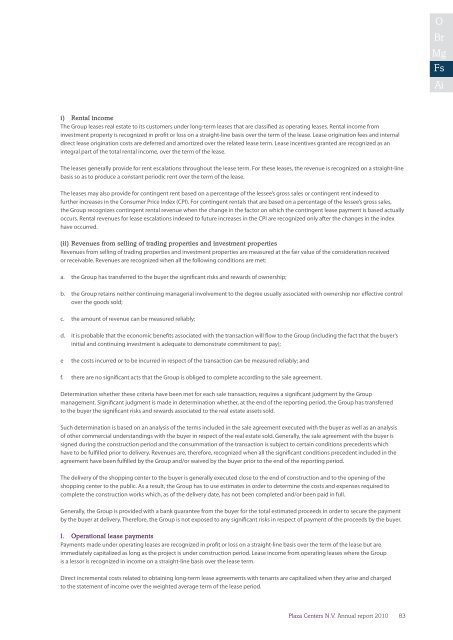Annual report 2010 - plazacenters
Annual report 2010 - plazacenters
Annual report 2010 - plazacenters
You also want an ePaper? Increase the reach of your titles
YUMPU automatically turns print PDFs into web optimized ePapers that Google loves.
O<br />
Br<br />
Mg<br />
Fs<br />
Ai<br />
i) Rental income<br />
The Group leases real estate to its customers under long-term leases that are classified as operating leases. Rental income from<br />
investment property is recognized in profit or loss on a straight-line basis over the term of the lease. Lease origination fees and internal<br />
direct lease origination costs are deferred and amortized over the related lease term. Lease incentives granted are recognized as an<br />
integral part of the total rental income, over the term of the lease.<br />
The leases generally provide for rent escalations throughout the lease term. For these leases, the revenue is recognized on a straight-line<br />
basis so as to produce a constant periodic rent over the term of the lease.<br />
The leases may also provide for contingent rent based on a percentage of the lessee’s gross sales or contingent rent indexed to<br />
further increases in the Consumer Price Index (CPI). For contingent rentals that are based on a percentage of the lessee’s gross sales,<br />
the Group recognizes contingent rental revenue when the change in the factor on which the contingent lease payment is based actually<br />
occurs. Rental revenues for lease escalations indexed to future increases in the CPI are recognized only after the changes in the index<br />
have occurred.<br />
(ii) Revenues from selling of trading properties and investment properties<br />
Revenues from selling of trading properties and investment properties are measured at the fair value of the consideration received<br />
or receivable. Revenues are recognized when all the following conditions are met:<br />
a. the Group has transferred to the buyer the significant risks and rewards of ownership;<br />
b. the Group retains neither continuing managerial involvement to the degree usually associated with ownership nor effective control<br />
over the goods sold;<br />
c. the amount of revenue can be measured reliably;<br />
d. it is probable that the economic benefits associated with the transaction will flow to the Group (including the fact that the buyer’s<br />
initial and continuing investment is adequate to demonstrate commitment to pay);<br />
e<br />
the costs incurred or to be incurred in respect of the transaction can be measured reliably; and<br />
f. there are no significant acts that the Group is obliged to complete according to the sale agreement.<br />
Determination whether these criteria have been met for each sale transaction, requires a significant judgment by the Group<br />
management. Significant judgment is made in determination whether, at the end of the <strong>report</strong>ing period, the Group has transferred<br />
to the buyer the significant risks and rewards associated to the real estate assets sold.<br />
Such determination is based on an analysis of the terms included in the sale agreement executed with the buyer as well as an analysis<br />
of other commercial understandings with the buyer in respect of the real estate sold. Generally, the sale agreement with the buyer is<br />
signed during the construction period and the consummation of the transaction is subject to certain conditions precedents which<br />
have to be fulfilled prior to delivery. Revenues are, therefore, recognized when all the significant conditions precedent included in the<br />
agreement have been fulfilled by the Group and/or waived by the buyer prior to the end of the <strong>report</strong>ing period.<br />
The delivery of the shopping center to the buyer is generally executed close to the end of construction and to the opening of the<br />
shopping center to the public. As a result, the Group has to use estimates in order to determine the costs and expenses required to<br />
complete the construction works which, as of the delivery date, has not been completed and/or been paid in full.<br />
Generally, the Group is provided with a bank guarantee from the buyer for the total estimated proceeds in order to secure the payment<br />
by the buyer at delivery. Therefore, the Group is not exposed to any significant risks in respect of payment of the proceeds by the buyer.<br />
l. Operational lease payments<br />
Payments made under operating leases are recognized in profit or loss on a straight-line basis over the term of the lease but are<br />
immediately capitalized as long as the project is under construction period. Lease income from operating leases where the Group<br />
is a lessor is recognized in income on a straight-line basis over the lease term.<br />
Direct incremental costs related to obtaining long-term lease agreements with tenants are capitalized when they arise and charged<br />
to the statement of income over the weighted average term of the lease period.<br />
<br />
Plaza Centers N.V. <strong>Annual</strong> <strong>report</strong> <strong>2010</strong>83








